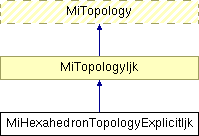MiHexahedronTopologyExplicitIjk Class Reference
[Topology]
 List of volume cells interface.
More...
List of volume cells interface.
More...
#include <MeshVizXLM/mesh/topology/MiHexahedronTopologyExplicitIjk.h>

Public Member Functions | |
| virtual void | getCellNodeIndices (size_t i, size_t j, size_t k, size_t &n0, size_t &n1, size_t &n2, size_t &n3, size_t &n4, size_t &n5, size_t &n6, size_t &n7) const =0 |
| virtual MiMeshIjk::StorageLayout | getStorageLayout () const |
| virtual size_t | getEndNodeId () const =0 |
| virtual size_t | getBeginNodeId () const |
Detailed Description
 List of volume cells interface.
List of volume cells interface.
A generic abstract interface for an unstructured explicit hexahedron volume mesh topology.
Each hexahedron cell has 6 faces which can be in any plane of the 3D space. Each face is a quadrangle not necessarily a square. The 4 first indices define the polygon of a face of the hexahedron. The 4 last indices define the polygon of the opposite face.
Facets and nodes are numbered as follows :
J
|
|
n3----------n2 facet 0 = 0123
/| /| facet 1 = 4765
/ | / | facet 2 = 0374
/ | / | facet 3 = 1562
n7---------n6 | facet 4 = 0451
| | | | facet 5 = 3267
| n0----|-----n1 --- I
| / | /
| / | /
|/ | /
n4---------n5
/
/
K
SEE ALSO
MbHexahedronTopologyExplicitIjk
- See related examples:
Member Function Documentation
| virtual size_t MiHexahedronTopologyExplicitIjk::getBeginNodeId | ( | ) | const [inline, virtual] |
Returns the first node id used by this topology. This topology uses only node index in the interval [beginNodeId,EndNodeId[. Thus the maximum node index used by the topology is getEndNodeId() - 1 and the number of nodes used by this topology is getEndNodeId() - getBeginNodeId(). This default implementation returns 0.
| virtual void MiHexahedronTopologyExplicitIjk::getCellNodeIndices | ( | size_t | i, | |
| size_t | j, | |||
| size_t | k, | |||
| size_t & | n0, | |||
| size_t & | n1, | |||
| size_t & | n2, | |||
| size_t & | n3, | |||
| size_t & | n4, | |||
| size_t & | n5, | |||
| size_t & | n6, | |||
| size_t & | n7 | |||
| ) | const [pure virtual] |
Returns the 8 indices of a cell of this topology.
The cell is identified by three ids i,j,k.
| virtual size_t MiHexahedronTopologyExplicitIjk::getEndNodeId | ( | ) | const [pure virtual] |
Returns the last node id + 1 used by this topology. This topology uses only node index in the interval [beginNodeId,EndNodeId[. Thus the maximum node index used by the topology is getEndNodeId() - 1 and the number of nodes used by this topology is getEndNodeId() - getBeginNodeId().
| virtual MiMeshIjk::StorageLayout MiHexahedronTopologyExplicitIjk::getStorageLayout | ( | ) | const [inline, virtual] |
Hint about cells organization in memory.
This information aims at optimizing the topology traversal for extractors. Returns the topology internal cells layout in memory as 6 enum values covering all possible cases.
For instance LAYOUT_KJI means that:
- the cell (i+1,j,k) is consecutive in memory to the cell (i,j,k) and,
- the row of cells (j+1,k) is consecutive in memory to the row of cells (j,k) and,
- the slice of cells (k+1) is consecutive in memory to the slice of cells (k)
The fastest way to go through the cells with LAYOUT_KJI should be to perform the following triple loop:
for each k with 0 <= k < numK
for each j with 0 <= j < numJ
for each i with 0 <= i < numI
topology.getCellNodeIndices(i,j,k,n0, ... ,n7);
The default implementation returns LAYOUT_UNKNOWN meaning that the cell storage organization is unknown, for instance when cells are computed on the fly. In that case, extractors perform the topology traversal in the way that minimizes the required memory for their algorithms.
The documentation for this class was generated from the following file:
- MeshVizXLM/mesh/topology/MiHexahedronTopologyExplicitIjk.h